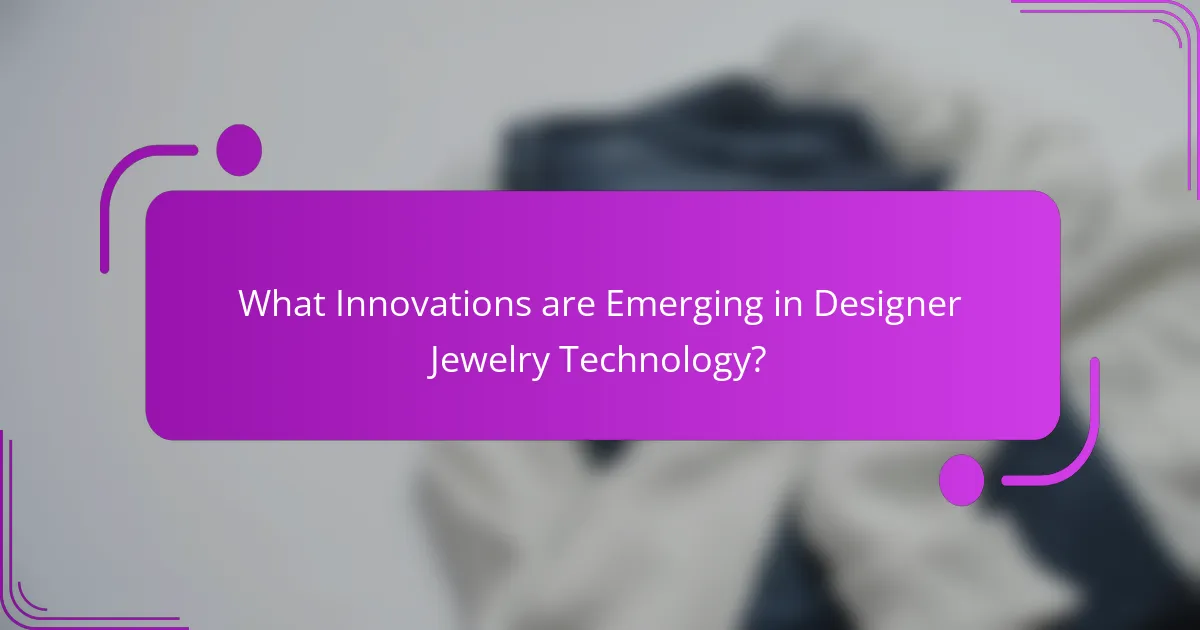The article examines the impact of technology on the designer jewelry industry, focusing on key innovations such as 3D printing, digital design tools, augmented reality, and blockchain. It highlights how these technologies enhance design processes, improve production efficiency, and create a more engaging shopping experience for consumers. The article also addresses the challenges associated with integrating new technologies with traditional craftsmanship, concerns about quality and durability, and the importance of sustainability in production. Overall, it provides a comprehensive overview of how technological advancements are reshaping the design, production, and sale of designer jewelry.

How is Technology Transforming the Designer Jewelry Industry?
Technology is transforming the designer jewelry industry by enhancing design processes and production efficiency. Digital design tools allow designers to create intricate patterns and visualize their pieces in 3D. This technology reduces the time needed for prototyping and enables rapid adjustments to designs. 3D printing facilitates the production of complex jewelry shapes that were previously difficult to achieve. This method also minimizes material waste, making production more sustainable. Additionally, technologies like augmented reality offer customers a virtual try-on experience, improving the shopping experience. According to a report by the Jewelry Industry Council, 3D printing can reduce production costs by up to 50%. These advancements are reshaping how jewelry is designed, produced, and sold.
What role does 3D printing play in designer jewelry creation?
3D printing plays a crucial role in designer jewelry creation by enabling precise and intricate designs. This technology allows designers to create complex shapes that traditional methods cannot achieve. It significantly reduces the time needed for prototyping. Designers can quickly iterate and modify their designs based on client feedback. Additionally, 3D printing minimizes material waste, making the process more sustainable. Customization becomes easier, allowing for personalized pieces tailored to individual preferences. According to a study published in the Journal of Cleaner Production, 3D printing can reduce material waste by up to 90%. This efficiency enhances creativity and innovation in jewelry design.
How does 3D printing enhance design possibilities for jewelers?
3D printing enhances design possibilities for jewelers by allowing intricate and complex designs that are difficult to achieve with traditional methods. This technology enables rapid prototyping, which accelerates the design process. Jewelers can create customized pieces tailored to individual client specifications. The precision of 3D printing ensures high-quality details and finishes. Additionally, it reduces material waste compared to conventional techniques. A study by the Journal of Cleaner Production highlights that additive manufacturing can lower material consumption by up to 90%. Overall, 3D printing revolutionizes jewelry design by increasing creativity and efficiency.
What are the cost implications of using 3D printing in jewelry?
The cost implications of using 3D printing in jewelry are significant. Initial investment in 3D printing technology can be high. However, it reduces material waste compared to traditional methods. This is due to additive manufacturing, which builds objects layer by layer. Labor costs may also decrease, as automation streamlines production. Customization becomes more feasible, allowing for unique designs without high costs. Additionally, production time is often shorter, leading to faster turnaround. A study by Wohlers Associates indicates that 3D printing can lower production costs by up to 50% in some cases. Overall, while upfront costs may be high, long-term savings and efficiencies can make 3D printing economically advantageous in jewelry making.
How is digital design reshaping the jewelry design process?
Digital design is transforming the jewelry design process by enabling precise modeling and rapid prototyping. Designers can create intricate designs using software like CAD (Computer-Aided Design). This technology allows for detailed visualizations before physical production. Additionally, digital tools facilitate customization to meet individual client preferences. The integration of 3D printing further streamlines the process, allowing for quick iterations of designs. Data from industry reports indicate that digital design reduces production time by up to 50%. This efficiency leads to lower costs and enhanced creativity in design. Overall, digital design is revolutionizing how jewelry is conceptualized and produced.
What software tools are commonly used in digital jewelry design?
Common software tools used in digital jewelry design include Rhino, MatrixGold, and ZBrush. Rhino is known for its versatility in 3D modeling. MatrixGold is tailored specifically for jewelry design, offering specialized tools. ZBrush is popular for its sculpting capabilities, allowing intricate detailing. Other tools include CAD programs like SolidWorks and SketchUp, which provide robust design functionalities. These software options are widely adopted in the industry for their effectiveness in creating detailed and precise jewelry designs.
How does digital design improve collaboration among designers?
Digital design improves collaboration among designers by enabling real-time sharing and feedback on projects. Designers can use collaborative tools like cloud-based software to work together seamlessly. This allows for immediate updates and changes, enhancing workflow efficiency. Visual communication through digital sketches and prototypes helps convey ideas more clearly. Moreover, digital platforms facilitate discussions and brainstorming sessions regardless of geographic location. Research shows that teams using collaborative design tools can increase productivity by up to 30%. These factors collectively lead to more cohesive and innovative design outcomes.

What Innovations are Emerging in Designer Jewelry Technology?
Emerging innovations in designer jewelry technology include 3D printing, augmented reality, and blockchain. 3D printing allows for intricate designs that were previously impossible to create. This technology enables rapid prototyping and customization at lower costs. Augmented reality enhances the shopping experience by allowing customers to visualize jewelry on themselves virtually. Blockchain technology ensures authenticity and traceability of materials used in jewelry. These innovations are transforming the industry by increasing efficiency and enhancing customer engagement. The combination of these technologies is reshaping how designer jewelry is created and sold.
How are new materials impacting designer jewelry?
New materials are significantly impacting designer jewelry by enabling innovative designs and enhancing functionality. Advanced materials like synthetic gemstones and bioplastics allow for unique aesthetics and sustainable practices. For instance, synthetic diamonds can be produced with lower environmental impact compared to mined diamonds. Additionally, materials such as carbon fiber and titanium offer lightweight and durable options for intricate designs. The introduction of 3D printing technology allows designers to experiment with complex geometries that were previously challenging to achieve. This technology also reduces waste, making the production process more efficient. Overall, new materials are expanding the creative possibilities for designers while promoting sustainability in the jewelry industry.
What are the benefits of using sustainable materials in jewelry design?
Using sustainable materials in jewelry design reduces environmental impact and promotes ethical practices. Sustainable materials, such as recycled metals and lab-grown gemstones, minimize resource depletion. They also decrease pollution associated with mining and production. Furthermore, sustainable practices often lead to a lower carbon footprint. According to a report by the World Gold Council, recycled gold can reduce energy consumption by up to 90%. Consumers increasingly prefer sustainable jewelry, driving demand for eco-friendly options. This trend enhances brand reputation and can lead to increased sales. Overall, using sustainable materials aligns with a growing commitment to environmental responsibility in the fashion industry.
How do innovative materials affect the durability of jewelry pieces?
Innovative materials significantly enhance the durability of jewelry pieces. These materials often possess superior strength and resistance to wear compared to traditional options. For example, titanium and carbon fiber are lightweight yet exceptionally durable. They can withstand daily use without easily scratching or bending. Additionally, advancements in synthetic gemstones provide enhanced hardness, making them less prone to chipping. Research indicates that jewelry made from innovative composites can last longer under stress. This increased durability leads to reduced maintenance and replacement costs for consumers. Overall, the integration of innovative materials results in longer-lasting and more resilient jewelry designs.
What are the latest trends in technology-driven jewelry design?
The latest trends in technology-driven jewelry design include the use of 3D printing, digital customization, and smart jewelry integration. 3D printing allows for intricate designs that were previously impossible to create. This technology enables designers to produce unique, personalized pieces quickly and efficiently. Digital customization tools let customers tailor their jewelry according to personal preferences. Smart jewelry integrates technology, offering features like fitness tracking and notifications. These trends reflect a shift towards personalization and functionality in jewelry design. According to a report by ResearchAndMarkets, the global 3D printing jewelry market is expected to grow significantly, indicating a strong demand for these innovations.
How is augmented reality being utilized in jewelry retail?
Augmented reality is utilized in jewelry retail to enhance customer experiences. Retailers provide virtual try-on features for customers. This technology allows users to see how jewelry looks on them in real-time. Customers can access these features through mobile apps or in-store displays. Studies show that augmented reality increases engagement and purchase intent. For instance, a report by Deloitte found that 40% of consumers are more likely to make a purchase after using AR. Additionally, retailers can use AR for personalized recommendations based on customer preferences. This integration of AR helps bridge the gap between online and in-store shopping experiences.
What future technologies could revolutionize the jewelry industry?
Future technologies that could revolutionize the jewelry industry include 3D printing, augmented reality, and blockchain. 3D printing allows for rapid prototyping and customization of designs. This technology reduces production costs and waste. Augmented reality enables customers to visualize jewelry on themselves before purchasing. This enhances the shopping experience and increases buyer confidence. Blockchain technology improves transparency in the supply chain. It ensures authenticity and ethical sourcing of materials. These technologies collectively enhance creativity, efficiency, and consumer trust in the jewelry industry.

What Challenges and Considerations Exist with Technology in Jewelry Design?
Technology in jewelry design presents several challenges and considerations. One major challenge is the integration of new tools with traditional craftsmanship. This can create a conflict between artisanal techniques and digital methods. Another consideration is the learning curve associated with advanced technologies like 3D printing and CAD software. Designers may require extensive training to effectively use these tools.
Additionally, there are concerns about the quality and durability of pieces produced through technology. Some consumers may perceive digitally produced jewelry as less valuable than handcrafted items. Intellectual property issues also arise as digital designs can be easily replicated. Lastly, sustainability is a significant consideration. The environmental impact of materials used in technology-based jewelry production must be evaluated.
What are the potential downsides of relying on technology for jewelry design?
Relying on technology for jewelry design can lead to a lack of creativity. Designers may become overly dependent on software, limiting their artistic expression. This reliance can result in homogenized designs that lack uniqueness. Additionally, technology can create a disconnect between the designer and the crafting process. Traditional techniques may be overlooked, leading to a loss of craftsmanship skills. The use of technology can also increase production costs. High-quality software and 3D printers require significant investment. Lastly, rapid technological changes can make equipment obsolete quickly, resulting in financial losses for designers.
How can designers balance traditional craftsmanship with modern technology?
Designers can balance traditional craftsmanship with modern technology by integrating both approaches in their creative process. They can incorporate techniques such as 3D printing to enhance precision while maintaining hand-crafted details. This allows for the production of intricate designs that may be difficult to achieve manually. Additionally, designers can use digital design tools to visualize their concepts before physical creation. This combination fosters innovation while respecting artisanal skills. Studies show that the fusion of these methods can lead to unique and marketable jewelry pieces that appeal to modern consumers. For example, brands like Tada & Toy have successfully merged traditional techniques with digital methods, resulting in award-winning designs.
What ethical concerns arise with the use of technology in jewelry production?
Ethical concerns in jewelry production technology include labor exploitation, environmental impact, and sourcing of materials. Technology can lead to reduced oversight in labor practices. This can result in workers facing unsafe conditions and low wages. Additionally, the use of technology may contribute to environmental degradation. For instance, 3D printing can generate waste and consume energy. Sourcing materials raises concerns about conflict minerals. These minerals can finance violence and human rights abuses. The jewelry industry must address these ethical issues to ensure responsible production practices.
How can designers effectively integrate technology into their work?
Designers can effectively integrate technology into their work by utilizing tools like 3D printing and digital design software. These technologies enable precise modeling and rapid prototyping of jewelry designs. For instance, 3D printing allows for intricate designs that are difficult to achieve with traditional methods. Digital design software, such as CAD programs, enhances creativity and accuracy in design. Studies show that 3D printing reduces production time by up to 90%. This integration leads to innovative designs and efficient production processes. Additionally, technology facilitates customization, allowing designers to create personalized pieces for clients. By adopting these technologies, designers can stay competitive and push the boundaries of their craft.
What best practices should designers follow when adopting new technologies?
Designers should prioritize user-centered design when adopting new technologies. This involves understanding the needs and preferences of the target audience. Conducting thorough research helps identify these user needs. Integrating feedback from users during the design process is crucial. Prototyping can help visualize concepts before full implementation. Testing prototypes allows for adjustments based on real-world use. Keeping abreast of industry trends ensures relevance in design. Continuous learning about new tools and technologies fosters innovation. Collaboration with technologists can enhance the design process.
How can technology be used to enhance customer engagement in jewelry design?
Technology can enhance customer engagement in jewelry design through interactive design tools. These tools allow customers to customize their jewelry pieces in real-time. For instance, 3D modeling software enables users to visualize their designs. Customers can adjust attributes like size, color, and material instantly. Virtual reality (VR) experiences can immerse customers in the design process. This creates a personal connection to the product. Augmented reality (AR) applications let customers try on jewelry virtually. This technology increases confidence in purchasing decisions. According to a study by McKinsey, personalized experiences can boost customer satisfaction by up to 20%. Thus, technology fosters deeper customer involvement in jewelry design.
The main entity of this article is the designer jewelry industry and its transformation through technology, specifically focusing on 3D printing and digital design. The article examines how these technologies enhance design processes, improve production efficiency, and enable customization, ultimately reshaping the industry. Key topics include the role of 3D printing in creating intricate designs, the impact of digital design tools on collaboration and prototyping, and the emergence of sustainable materials and innovations such as augmented reality and blockchain. Additionally, the article addresses the challenges and ethical considerations associated with integrating technology into jewelry design.